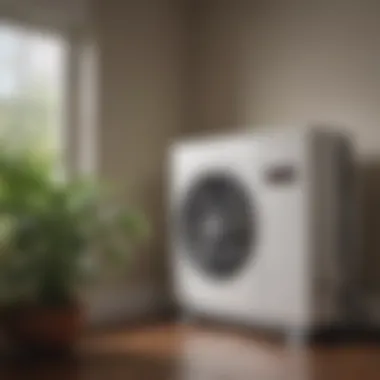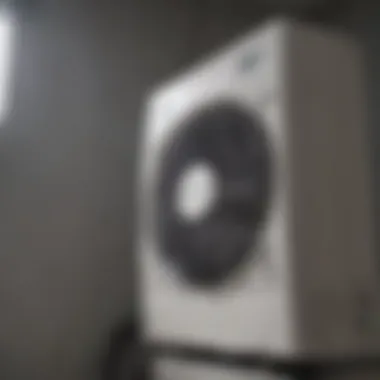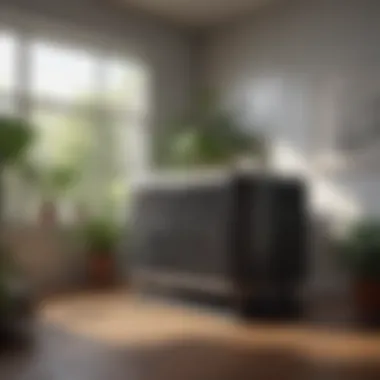Understanding Average Costs of New Central Air Units


Intro
Purchasing a new central air conditioning unit is a significant investment for many homeowners. Understanding the average cost associated with this purchase is crucial. This article will break down the factors that dictate pricing. By examining the types of units available, installation expenses, and ongoing maintenance, readers will be better equipped to navigate their choices. Additionally, we will discuss energy efficiency and the long-term financial implications of these systems.
Having a well-functioning air conditioning system is not a luxury; it is essential, especially during hot months. Understanding both the immediate costs and the future expenses related to these units can lead to better decision-making and enhanced comfort in your home.
Design Inspirations
While the main focus of this article is on cost, there can be a connection with design. Selecting a central air unit that fits well with your home can also influence choices. Some modern units are designed to blend with various home aesthetics. Homeowners are often looking for units that not only work effectively but also look good.
Trending Styles
With advanced technology, different styles have emerged that cater to a diverse range of architectural designs. Homeowners may consider sleek, minimal designs that maintain the beauty of their home's appearance.
- Ductless Mini-Splits: These provide versatility and can be placed almost anywhere. They are particularly popular in homes with limited duct work.
- Traditional Central Units: These remain a staple in many homes, offering reliability and efficiency.
Selecting a unit that matches your interior design vision can enhance your space while ensuring a comfortable environment.
Color Palettes
Most air conditioning units come in neutral colors. White and light gray are common shades that allow these units to blend into their environment. Some brands may offer other color options, giving homeowners an extra layer of choice. Matching the unit either with walls or nearby structures creates a cohesive appearance.
"Choosing the right air conditioning unit involves both functionality and aesthetic harmony with the home."
Maintenance and Upkeep
After investing in a central air unit, the next important topic is maintenance. Proper upkeep prolongs the lifespan of the system and keeps it running efficiently, which can save homeowners money in the long term.
Seasonal Maintenance Checklist
- Change Filters Regularly: Ensuring clean air filters enhances efficiency and air quality.
- Inspect Ductwork: Look for leaks or blockages that could hinder performance.
- Check Thermostat Settings: Test the thermostat to ensure the unit responds correctly to temperature changes.
- Schedule Professional Maintenance: Annual checkups by a certified technician can catch problems early.
Cleaning and Organization Tips
Keeping the area around the air conditioning unit clean helps with performance. Clear away debris, such as leaves and dust, to ensure proper airflow. Furthermore, organizing the space where the HVAC components reside can facilitate easier access for maintenance.
Factors Influencing the Cost of Central Air Units
The cost associated with purchasing a new central air conditioning unit can vary significantly. Understanding the factors that influence the cost helps homeowners make informed decisions. When consumers are aware of how different elements impact pricing, they can better assess their options and budget appropriately. These elements include the type of system, unit size, brand considerations, installation complexity, and the timing of purchase. Each factor has its implications, whether it is related to efficiency, durability, or short-term financial commitments.
Type of System
The type of air conditioning system is one of the most significant factors affecting cost. The market has various systems like split-systems, packaged units, and ductless mini-splits. Each type serves different needs and environments. For instance, a split-system may be more appropriate for larger homes, while ductless models are ideal for those seeking energy efficiency in smaller spaces.
In general, split-systems tend to have higher upfront costs compared to packaged units, which can be more affordable but may lack certain features. Homeowners should consider not only the immediate costs but also the long-term benefits and efficiencies of each system type.
Size of the Unit
The size of the air conditioning unit is another critical determinant. Units are rated by BTUs, and selecting the correct size ensures optimal performance. An undersized unit will struggle to cool the room adequately, leading to higher energy bills and earlier wear and tear. In contrast, an oversized unit can lead to short cycling, which can cause humidity issues and ultimately reduce efficiency.
Homeowners should ensure proper assessments are made to match the air conditioner size with home specifications, such as square footage, insulation quality, and local climate.
Brand Considerations
Brand preference also influences costs. Well-known brands like Carrier, Trane, and Lennox often come with higher price tags due to their reputation for quality and reliability. These brands usually provide better warranties and customer service, which can be valuable for long-term investment. On the other hand, lesser-known brands may offer lower prices but also carry a higher risk of limited support and durability.
Choosing a brand should involve weighing initial costs against overall value, reliability, and expected lifespan.
Installation Complexity
Installation complexity can significantly contribute to the overall cost of the central air unit. Simple installations may require less labor and hence incur lower costs. However, installations that demand complex ductwork, electrical work, or modifications to existing structures may increase costs considerably.
It is advisable for homeowners to consult with professionals to assess installation needs accurately before making a purchase. Proper installation is crucial for maximizing efficiency and longevity.
Time of Purchase


Timing can affect purchasing decisions in many ways. Seasonal fluctuations often bring about different pricing strategies. For example, buying during the off-peak season or winter months may yield substantial savings, as demand decreases and retailers offer promotions. Conversely, purchasing during peak summer months typically results in price hikes due to increased demand.
Estimating the Average Costs
Estimating the average costs of a new central air unit is critical for homeowners looking to make informed decisions about climate control. Understanding these costs can lead to better budgeting, which plays an essential role in financial planning. Additionally, it aids in comparing various options available in the market. The average costs encompass not only the unit itself but also the associated expenses, including installation and additional materials. This comprehensive approach ensures that homeowners clearly comprehend their financial commitments before making a purchase.
National Averages
National averages provide a useful benchmark for homeowners. They reveal the general price range for central air units across the United States. These averages can fluctuate based on several factors, including market demand, seasonal changes, and national economic conditions. Knowing these averages helps consumers gauge if a quote they receive falls within a reasonable range. Consequently, homeowners are better equipped to negotiate prices or avoid overpaying for their new unit.
Regional Variations
Regional variations in pricing are also significantly relevant. Factors such as local climate, cost of living, and regional labor rates can create notable differences in costs. For instance, areas with extreme temperatures may see higher demand for air conditioning units, directly impacting prices. Understanding these variations allows consumers to align their expectations with their specific location. It can also highlight the importance of shopping around within the region for better deals.
Cost Breakdown
The breakdown of costs reveals essential insights into what homeowners can expect to pay. It divides expenses into three main categories: unit cost, installation fees, and additional materials.
Unit cost
The unit cost is the foremost expense in acquiring a central air conditioning system. This cost can vary significantly depending on the type and efficiency of the system. Higher efficiency systems may come with a steeper price tag, but they tend to offer better long-term savings on utility bills. Choosing the right unit based on size and efficiency ratings can lead to favorable outcomes for homeowners in terms of comfort and utility costs.
Installation fees
Installation fees contribute significantly to the overall cost as well. These fees are determined by the complexity of the installation process and the local labor market. A complex installation might require additional components or expertise, thus increasing the costs. While investing in a professional installer may initially seem costly, their expertise can pay off, ensuring a proper setup and potentially extending the unit’s lifespan.
Additional materials
Additional materials are often required for the installation, such as ductwork or electrical components. This aspect can catch some homeowners off guard. While it may only seem to be a minor detail, the cost of additional materials can add up quickly, affecting the total price significantly. Ensuring a complete understanding of these materials and their costs is essential for accurate budgeting and planning.
"Understanding all aspects of costs enables homeowners to make better choices and avoid unplanned expenses."
This overview of estimating average costs aims to provide clarity. A well-informed decision can result in long-term satisfaction and comfort in your home, making it well worth the effort to explore and understand these financial components.
Types of Central Air Conditioning Systems
In the landscape of climate control, selecting the right type of central air conditioning system is critical. Each type serves distinct needs and preferences, influencing both comfort and cost. Understanding these systems helps homeowners make informed decisions that align with their unique requirements.
Split-System Air Conditioners
Split-system air conditioners consist of two main components: an indoor unit and an outdoor unit. This design allows for efficient cooling and quiet operation, as the noisy components are located outdoors. The flexibility of installation is one of its strengths. Homeowners can choose locations for the indoor unit that optimize airflow within the space. Such systems can also feature multiple indoor units connected to a single outdoor unit, offering zoned cooling for larger spaces. Energy efficiency is another aspect to consider, with many split systems boasting high Seasonal Energy Efficiency Ratio (SEER) ratings. This can lead to long-term savings on energy bills, making it a wise investment.
Packaged Air Conditioners
Packaged air conditioners combine all components into one unit, typically installed on the roof or beside the building. This system is ideal for homes with limited indoor space, as it eliminates the need for separate indoor and outdoor units. Ease of installation is also a significant advantage. With fewer components to install, the process can be quicker and less disruptive. However, homeowners should consider potential boxy aesthetics, as packaged systems can be less visually appealing. Additionally, they must ensure proper access for maintenance services, as units positioned on a roof or high ground can pose challenges.
Ductless Mini-Split Systems
Ductless mini-split systems are an increasingly popular option for homeowners seeking flexibility and efficiency. Similar to split systems, they consist of an indoor and outdoor unit but do not rely on ductwork to distribute air. This feature enables installation in homes without existing ducts. Each indoor unit can be controlled independently, allowing for targeted cooling in specific rooms or zones. The absence of ducts also minimizes energy loss, as a significant portion of cooled air in traditional systems is lost during distribution. This makes ductless systems an appealing choice for energy-conscious homeowners.
Understanding the differences between these air conditioning systems allows homeowners to analyze their specific needs, budget, and home layout. Each style of system presents unique benefits and considerations, which contribute to the overall cost when installing a new central air unit.
Installation Considerations
When bringing a new central air conditioning unit into your home, understanding the installation considerations is essential. Poor installation can lead to inefficiency, higher utility bills, and even premature system failure. Therefore, focusing on the right aspects of installation ensures optimal performance and longevity of your air conditioning unit.
Choosing a Qualified Installer
Selecting a qualified installer is critical. A skilled professional does more than just place the unit in your home. They assess your property, determine the correct size and system type, and ensure proper installation. This includes securing all connections, testing functionality, and checking for energy efficiency. Investing time in finding licensed and experienced installers is worthwhile. You can check online reviews or get recommendations from family and friends.
- Professional Credentials: Ensure the installer is licensed and insured. This protects you financially in case of issues post-installation.
- Experience with Similar Systems: Talk to the installer about their experience with the specific type and brand of the unit you are purchasing.
Permits and Regulations
Permits and regulations can be complex when installing central air systems. Depending on your area, local laws may require specific permits to ensure installations are up to code. Not obtaining necessary permits can result in fines. Furthermore, many insurance policies stipulate that all installations must comply with local guidelines. To address this:
- Consult Local Authorities: Before moving ahead, check with your local building department to understand the regulations applicable.
- Installation Permits: Ensure that your installer handles the required permits. This can save you from dealing with paperwork and legalities.


Pre-Installation Preparation
Preparation before installation can significantly impact the success of your unit. Take some time to get your home ready for the new system.
- Clearing Space: Make sure the unit's installation area is clear of clutter. This gives the installer enough room to work and ensures an efficient installation process.
- Electrical Requirements: Check if any electrical upgrades are needed before installation. The new system may require more power than your home currently provides.
- Assess Home Insulation: Evaluate your home’s insulation. Proper insulation improves efficiency and helps the air conditioning system perform better.
"A good installation is the backbone of an effective air conditioning system; neglecting this aspect can lead to costly repairs and lower comfort levels in your home."
Taking these installation considerations seriously allows you to enjoy your new central air unit with peace of mind.
Energy Efficiency and Cost Implications
The subject of energy efficiency is crucial when considering the average cost of a new central air unit. Understanding how energy efficiency impacts both pricing and long-term ownership costs can empower homeowners to make informed choices. An energy-efficient air conditioner can deliver significant benefits, both environmentally and economically.
When looking at energy efficiency, a primary element to consider is the Seasonal Energy Efficiency Ratio, or SEER rating. This rating reflects the cooling output of an air conditioner divided by its energy consumption over a typical cooling season. A higher SEER rating means better efficiency, which can lead to lower utility bills.
Understanding SEER Ratings
The SEER rating is an essential metric for evaluating air conditioning units. These numbers typically range from about 13 to 25 in modern units. Each increase in the SEER rating translates to heightened energy efficiency. While units with higher ratings may come at a premium upfront, they often provide substantial savings over time. For instance, upgrading from a SEER 13 unit to a SEER 16 unit can result in a savings of 20% on energy bills.
Homeowners should assess the SEER ratings of different units against their specific needs. Factors impacting this decision include the local climate, home insulation, and how often the air conditioning will be used. Noticing trends in energy consumption can help validate whether a higher SEER rating is justified based on individual usage.
Long-Term Savings
Investing in an energy-efficient central air unit can yield considerable long-term savings. While the initial purchase and installation might be higher, the cumulative reduction in energy costs can make it a financially wise decision.
Benefits of long-term savings include:
- Reduced electricity bills, which can be significant in hot climates
- Decreased likelihood of costly repairs associated with overworked systems
- Extended lifespan of the unit due to less strain from efficient operation
Additionally, with various advanced technologies now available, central air units can optimize performance and even adjust output based on current home conditions. By being selective about energy efficiency, homeowners can enhance comfort while lowering costs in the long run.
Rebates and Incentives
Various rebates and incentives are available for homeowners who choose to purchase energy-efficient air conditioning systems. Government programs, utility companies, and local municipalities often have initiatives aimed at promoting energy efficiency. It is important to research what is available in your area, as these incentives can significantly offset the initial costs involved in purchasing a new system.
Some common types of incentives may include:
- Cash rebates directly from manufacturers or local utility companies
- Federal tax credits for energy-efficient upgrades
- Low-interest financing options through specially designated programs
Utilizing these financial incentives can enhance the value of investing in a more efficient air conditioning system. Not only does this decision promote an environmentally conscious approach, but it also positions the homeowner for favorable financial outcomes.
Maintenance Costs Over Time
Understanding maintenance costs over time is essential when considering the total investment in a new central air unit. This section will break down the importance of routine maintenance, potential repairs, and their implications on long-term expenses. Regular upkeep not only preserves the functionality of the unit but also influences energy efficiency, which in turn affects your utility bills. Knowing what to expect in terms of maintenance costs can aid homeowners in budgeting effectively for their air conditioning needs.
Routine Maintenance
Routine maintenance is critical for the longevity and efficiency of your central air system. Regular checks and actions can prevent small issues from becoming larger, more costly problems down the line.
- Filter Replacement: It is recommended to replace or clean the air filter every 1 to 3 months. A clogged filter can lead to increased energy costs, impacting your budget over time.
- Annual Inspections: Scheduling yearly inspections with a qualified technician is advisable. These inspections can identify potential issues early, reducing the chances of unexpected breakdowns.
- Cleaning Coils: The evaporator and condenser coils should be cleaned to maintain optimal operation. Dirty coils can impede performance and increase energy consumption.
- Checking Refrigerant Levels: Ensuring the right levels of refrigerant is important. Low levels can indicate a leak, which could potentially lead to costly repairs if not addressed promptly.
Maintaining the air conditioning unit proactively can save homeowners significant amounts over its lifespan, reinforcing the importance of budgeting for routine maintenance as a part of overall air conditioning costs.
Potential Repairs
Despite best efforts in maintenance, repairs may still be necessary from time to time. Being aware of common issues can help homeowners stay prepared financially.
- Compressor Problems: This key component can fail and often requires substantial repair or even replacement. Monitoring system sounds and performance can catch issues early.
- Electrical Failures: Wiring and electrical components are susceptible to wear and tear, resulting in potential failures. This is something to keep in mind when calculating maintenance budgets.
- Thermostat Issues: A malfunctioning thermostat can lead to inconsistencies in temperature control and increased energy bills. Replacing it can be a straightforward fix, but it is essential to ensure it is functioning correctly.
- Leaking Ducts: Ductwork can develop leaks over time, leading to inefficiency. Sealing ducts can be an essential maintenance step that often goes overlooked.
It's prudent to set aside funds for potential repairs each year. Estimates suggest homeowners spend anywhere from a few hundred to several thousand dollars on repairs throughout the lifespan of the unit, depending on the frequency and severity of issues faced.
In summary, understanding maintenance costs over time encompasses both scheduled maintenance and potential repair expenses. It empowers homeowners to manage their budgets better and maintain an efficient climate control system.
Financing Options for Central Air Units


Understanding financing options is crucial when considering the purchase of a new central air unit. These units can represent a significant investment, often requiring homeowners to explore various ways to manage costs over time. Financing provides flexibility, allowing individuals to spread payments over an extended period instead of facing a heavy upfront expense. Different financing methods cater to different financial situations and preferences, and knowing the options can assist homeowners in making informed decisions.
Personal Loans
Personal loans are a popular choice for financing home improvement projects, including central air conditioning units. These loans are typically unsecured, meaning they do not require collateral, which reduces the risk for the borrower.
When opting for a personal loan, homeowners should consider interest rates, repayment terms, and any associated fees. Interest rates can vary greatly among lenders and may depend on the borrower's credit score. A higher credit score often leads to more favorable rates.
Benefits of personal loans include:
- Flexibility: Funds can be used for various expenses, not just the air unit itself.
- Fixed Payments: This makes budgeting easier as homeowners know exactly what to expect each month.
- No Down Payment: Many personal loans do not require a down payment, allowing homeowners to start their projects sooner.
Credit Cards
Using credit cards is another option for financing a new central air unit. Many people use credit cards for their convenience, especially if they are already available. However, it can be a double-edged sword.
Consideration of interest rates is essential. Credit cards often have higher interest rates compared to personal loans. Therefore, if the balance is not paid off quickly, the cost of borrowing can escalate.
Advantages of using credit cards include:
- Rewards Programs: Some cards offer rewards or cashback on purchases, which can lead to savings over time.
- Promotional Offers: Many credit cards periodically provide promotional interest rates, such as zero percent for a certain period, reducing initial costs.
- Immediate Access to Funds: Homeowners can make a purchase immediately without waiting for loan approval.
Store Financing Programs
Store financing programs, often offered by HVAC retailers or manufacturers, can simplify the purchasing process for central air units. These programs are designed specifically for the products sold by the store and frequently provide promotional financing options.
These financing plans can range from deferred payment options to flexible installment plans. Homeowners should review the terms carefully, looking for hidden charges or high-interest rates that could arise after promotional periods.
Key aspects to consider with store financing include:
- Promotional Rates: Low or zero-interest financing for promotional periods can provide temporary relief.
- Convenience: Often, the application and approval process are straightforward, making it quicker to secure financing.
- Specific to Products: Financing is often limited to items purchased in the store, which can be useful for those committed to a particular brand.
Choosing the right financing option can significantly impact the overall cost of a new central air unit, affecting monthly budgets and long-term financial health. Homeowners must evaluate these options based on individual financial circumstances and project needs. The goal should always be to balance affordability with quality and efficiency.
Choosing the Right Unit for Your Home
Choosing the right central air unit is crucial because it directly affects comfort, efficiency, and costs. The right unit ensures an even distribution of cool air throughout your space. If you select a unit that is not sized properly or lacks necessary features, you might find yourself facing discomfort or higher energy bills. A well-chosen air conditioner contributes positively to indoor air quality and energy efficiency. In a market filled with various options, understanding how to select the right unit becomes essential for homeowners.
Assessing Your Home's Needs
To choose the right central air unit, begin by assessing your home’s specific needs. Factors such as the size of your home, insulation quality, and average local temperatures play significant roles in this process. Evaluate the square footage of your space. A unit that is too small will struggle to cool adequately while one that is too large may cycle on and off excessively, wasting energy.
- Square Footage: Measure the total area. Typically, one ton of cooling capacity can cover approximately 600 to 800 square feet.
- Insulation: Check how well your home retains cool air. Poor insulation can increase the required cooling capacity.
- Sunlight Exposure: Consider the number of windows and their orientation. Homes with many windows facing the sun will require more cooling power.
- Occupancy Levels: Larger families or frequent gatherings can increase heat levels. Adjust the capacity based on how often the space is used.
Gathering all this information will provide a clearer picture of what size and type of unit will meet your needs.
Consulting with Professionals
Once you assess your home’s needs, it is beneficial to consult with professionals. HVAC experts can offer insights that you may not consider. They possess the knowledge to evaluate your home more comprehensively and recommend the appropriate systems.
- System Evaluations: Professionals can perform calculations, like Manual J load calculations, to determine the right cooling load. This calculation takes into account all specific factors—insulation, windows, and existing ducts.
- Advice on Efficiency Ratings: They can help in selecting units with optimal Energy Efficiency Ratio (EER) or Seasonal Energy Efficiency Ratio (SEER) ratings, ensuring your unit operates effectively while saving energy.
- Future Trends and Upgrades: Professionals often have information about emerging technologies in HVAC systems. They provide recommendations that align with both current needs and future considerations.
Ultimately, consulting with these experts can save you time, money, and frustration in the long run, ensuring you invest in a system that perfectly matches your circumstances.
Common Myths About Central Air Conditioning Costs
Understanding the common myths surrounding central air conditioning costs is critical for homeowners. Many misconceptions can lead to poor decision-making regarding the purchase and maintenance of these systems. Unraveling these myths can save consumers money and guide them toward more efficient choices. Acknowledging these myths allows individuals to approach air conditioning with a clearer perspective, making informed decisions that can enhance their home comfort and financial well-being.
Myth: Higher Price Equals Better Quality
This myth suggests that the most expensive central air conditioning units will always provide the best performance and longevity. While it is true that many premium units come with advanced features and better energy efficiency ratings, a higher price tag does not guarantee superior quality.
Numerous factors determine a system's quality, including construction materials, installation quality, and even the intended use of the unit. Some mid-range models may actually provide comparable performance at a lower cost. To avoid falling for this myth, it's crucial to do thorough research, read product reviews, and consider the specific requirements of your home before making a purchase.
Myth: Maintenance is Too Expensive
Another prevalent misconception is that maintaining a central air conditioning system is overly costly and time-consuming. While maintenance does require an investment, it is essential for extending the lifespan of your unit and ensuring optimal performance. Regular upkeep can prevent more severe and costly repairs down the line.
The average cost of routine maintenance services typically ranges between $75 to $150 per service visit. This cost can be significantly lower than the expense incurred from major repairs or even replacing a unit due to neglect. Therefore, investing in regular maintenance is not just financially wise, it’s also beneficial for your home's overall climate control efficiency.
"Investing in regular maintenance can save you money in the long run by preventing costly repairs in the future."
In summary, challenging these myths allows homeowners to approach their air conditioning systems with more clarity. By understanding that price does not always indicate quality and by recognizing the importance of maintenance, individuals can make choices that lead to better performance and savings.







